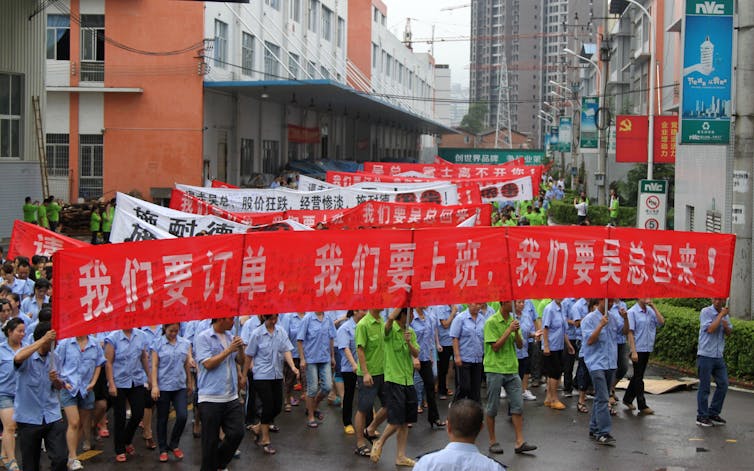China’s industrial landscape is in a process of rapid transformation. As low-end industries are squeezed by rising costs for land, labour and other resources, the Chinese government has reinforced its efforts to improve industrial practices and make production models more sophisticated. Sadly, however, these changes have not improved the lot of the more than 150m migrant workers who fill the factories.
Case studies I’ve conducted in the garment and LED lighting industries show that companies do engage in ways to upgrade industry practice. They increase their investment in modern equipment to make production more efficient and meet higher quality standards. They also launch their own brands in order to capitalise on China’s huge consumer market and to overcome their dependence on foreign firms that used to reap most of the profits. Finally, they also invest in their own research facilities and improve their management capabilities.
These changes could serve to improve the notoriously bad working conditions in manufacturing industries in China’s industrial heartland – the Pearl River Delta region. The huge development here was based on the exploitation of millions of rural migrant workers who worked at meagre wages for up to 80 hours a week. This labour regime entails a high turnover rate of the mostly young workforce at its disposal. Trade union representation and other channels to voice dissent are usually absent.
Driven by poverty in their places of origin and the seduction of a modern life in the city, young migrant workers used to accept a phase of intense exploitation in this workshop of the world, with the prospect of earning money to lay the foundation for founding a family and building a house.
Recently, however, young migrant workers have been less prepared to accept this fate. They increasingly look to adopt urban lifestyles and have dreams to sustain a life in the city that is unaffordable on factory wages. The past five years therefore have seen the growth of labour conflict in China which culminated in a huge strike at the world’s largest shoe contract manufacturer involving 40,000 workers.
Unbearable conditions
Although there is mounting evidence that the present labour regime is unbearable, industrial transformation contributes little to improve working conditions – be it in terms of wages, skills or employment patterns. Instead, the results from my empirical investigation at 16 technologically advanced companies in the Pearl River Delta reveal that modern technology is combined with the old ways of hiring cheap, low-skilled migrant workers at the level of manufacturing.
Surprisingly, this not only accounts for the traditional garment industry of the region – the embodiment of low-end labour-intensive manufacturing. It also accounts for the high-tech LED lighting industry, a strategic emerging industry particularly supported by government subsidies. The following shortcomings could be observed at the surveyed companies:
When upgrading rests on automation, the equipment is deliberately designed in a way that guarantees very easy operation so that it can be operated “almost by illiterates” as one manager told me.
When upgrading focuses on brand building, the changes are often limited to design and marketing tasks and barely change conditions on the shop floor.
The introduction of lean production techniques at one large fashion brand resulted in worse conditions for workers. Workers at this company could be hired without prior working experience, were trained for a period of a few days only and earned lower wages than their peers.
This is not to say that upgrading industry practices does not result in any higher skill requirements and wages. But where it does it mostly affects white collar workers in the areas of engineering, design and marketing, as well as a few technicians. With few exceptions, however, manufacturing workers in the Pearl River Delta do not reap any benefits from the modernisation of their industries.

Rising demands
If the lot of the migrant workers that continue to power China’s economy is to improve, it is not enough to wait for trickle down effects of technological change. There has been a trend of rising wages for manufacturing workers in recent years, but it results from general labour shortages and a rising tide of social conflicts, not from the effects of technological change. This is clear from the fact that wage rises have been the same in both companies that are more modern and those that have been slow to innovate.
The main driver of wage rises has been workers themselves demanding it – either through taking advantage of the worker shortage or through social unrest. So if China’s industry is to see a transformation that doesn’t just improve the profits of factory owners, it will be workers themselves who will lead the way.

